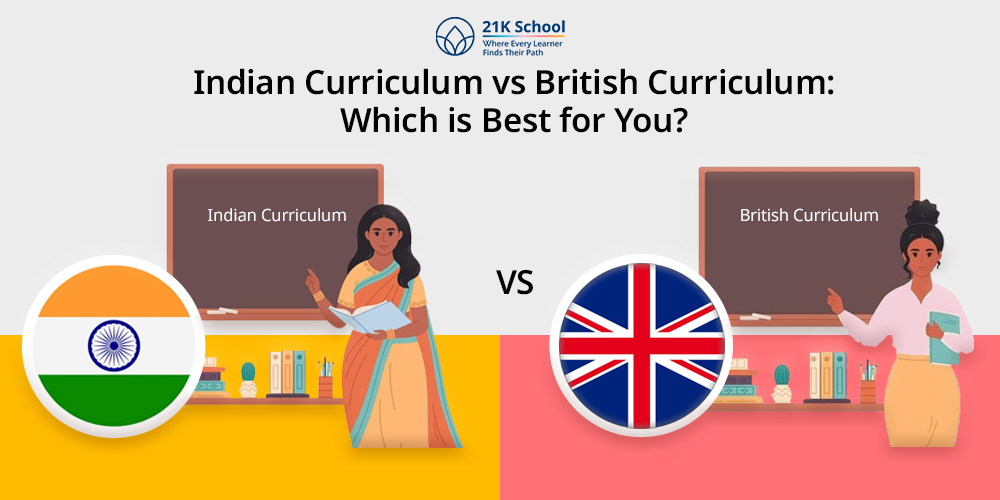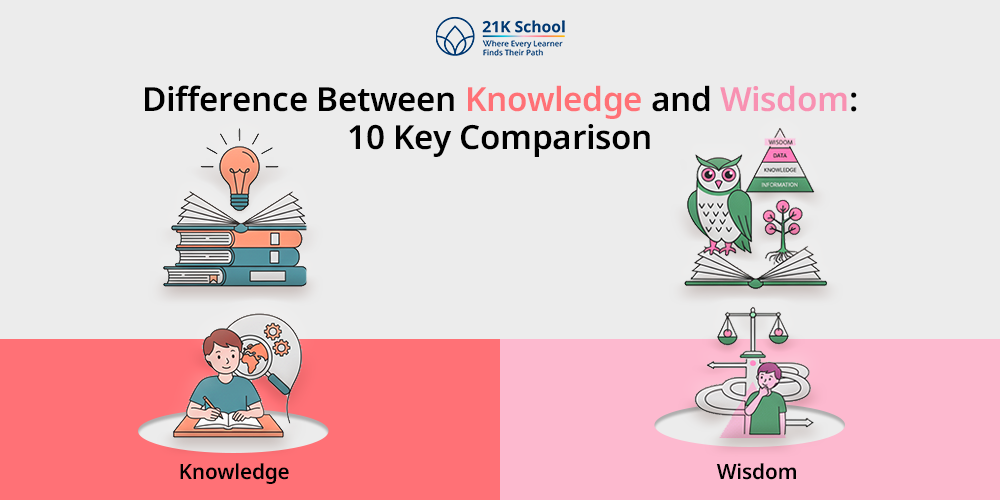
The education journey of a learner has various ups and downs and taking the right decision is important for a career. The curriculum in any education board plays a crucial role.
Among the most common choices in India and other parts of the world:
- The Indian Curriculum such as CBSE, ICSE and State Board.
- The British Curriculum commonly known as the National Curriculum of England or Cambridge IGCSE/A-level.
Each has its strengths, challenges and areas of focus which makes them unique. For learners a bright future needs the right choice.
Here, we will break down the major differences between the two. And how the selection is beneficial for learners’ future growth.
Table of Contents
What is the Indian Curriculum?
The Indian curriculum maintained by NCF stands for National Education Policy. It is created to provide education, especially children’s from age 3 to 18.
The Indian curriculum is designed with the help of National Education Policy in which the curriculum has been structured into four stages (5+3+3+4).
The Indian curriculum also focuses on various streams such as Science, Arts, Commerce and additional subjects like local and foreign language.
Also, learn the benefits of learning a foreign language.
What is the British Curriculum?
The British curriculum is also popular as the National Curriculum for England. It is a world wide recognised curriculum focused on vast and advanced learning.
The curriculum guides individuals to learn problem solving, critical thinking skills and learning with different subjects.
Indian Curriculum Vs British Curriculum: Key Differences
Understanding the main difference between the Indian and British curriculum helps to choose the best.
Below is a detailed description of the 10 points which shows the comparison between both:
1. Curriculum Design
The Indian curriculum is designed according to standardised exams structure learning and theoretical knowledge.
While the British curriculum has a modular system which is based on critical thinking, flexible and practical application based.
2. Flexibility
Flexibility is a crucial part of every curriculum. Flexibility in learning is ideal for learners to increase productivity.
In Indian curriculum flexibilities are low as compared to the British curriculum.
3. Assessment Methods
The method of assessment in the Indian curriculum is exam centric. On the other hand, the British curriculum works with continuous assessment coursework and project based learning.
4. Teaching Approach
Teaching approach is one of the impactful parts that can enhance child’s academic performance. The Indian curriculum uses teacher-led techniques.
While the British curriculum mainly works with a student-centred teaching approach in their curriculum.
5. Global Recognition and University Admissions
The recognition of the Indian curriculum is higher in India and moderate in other countries.
For the British curriculum recognition is globally accepted by every University and colleges.
6. Language of Instruction
The language of instructions in the Indian curriculum is mainly English and also available in regional languages.
While for the British curriculum, English is majorly used by everyone. One can also explore the importance of regional language for kids in learning.
7. Cost and Availability
Indian curriculum is generally more affordable and widely available. On the other hand, the British curriculum is more costlier and mainly found in international or private schools.
8. Transition and Mobility
Transitioning between schools may be smoother within India.
However in the British curriculum easier global mobility and continuity due to uniform international standards.
9. Learning Style
The Indian curriculum focuses on memorization and structured learning.
And the British curriculum mainly focuses on independent learning and application of knowledge.
10. Pedagogical Approaches
The Indian curriculum is based on traditional schooling and the teacher is the main source of knowledge.
In the British curriculum teachers act more as facilitators, promoting student participation.
Also explore the difference between Indian curriculum vs American curriculum.
Comparison Table of Indian Curriculum Vs British Curriculum:
| S.No. | Particulars | Indian Curriculum | British Curriculum |
| 1. | Curriculum Design | Indian Curriculum design is Standardized (CBSE, ICSE, State Boards) | British Curriculum design is Modular (IGCSE, A-Levels) |
| 2. | Flexibility | Flexibility in the Indian curriculum is lower than the British curriculum | Flexibility in the British curriculum is higher than the Indian curriculum |
| 3. | Assessment Methods | Assessment methods here are exam-heavy. | Assessment methods here are continuous & diverse assessment. |
| 4. | Teaching Approach | A teacher-led teaching approach is used. | A student-centered teaching approach is used. |
| 5. | Global Recognition and University Admissions | High in India, moderate abroad | Globally recognized |
| 6. | Language of Instruction | Language of instruction is english/regional languages | The language of instruction is English. |
| 7. | Cost and Availability | The cost and availability is affordable. | The cost and availability is relatively high. |
| 8. | Transition and Mobility | The Indian curriculum is best for local transitions. | The British curriculum is ideal for international moves |
| 9. | Learning Style | The learning style of the Indian curriculum is theory & memorization based. | The learning style of the British curriculum is skill development & critical thinking. |
| 10. | Pedagogical Approaches | It is valued in Indian & some international universities. | It is highly valued worldwide. |
Explore the difference between Indian education system and foreign education system.
Pros and Cons of Indian Curriculum
Every curriculum has its pros and cons, just like the Indian curriculum. It offers various advantages and disadvantages to learners.
Here we will go through some common pros and cons:
1. Affordable Education
Learners can access affordable education if they choose an Indian curriculum for further studies. It offers high quality learning at minimal fees.
2. Activity-Based Learning
Activity-based learning means the Indian curriculum provides the opportunity to learn things other than course or subject.
Active participation dealing with real life situations, critical thinking and problem-solving ensures overall growth.
3. Emphasis on STEM
Focus or emphasis on STEM method refers to the Indian curriculum which provides multi stream options such as science Commerce Arts etc.
Learners have the opportunity to choose any for their studies.
Some common cones of the Indian curriculum includes:
4. Rote Learning
Rote learning in the Indian curriculum means learning and repetition of concepts for memorizing.
The method sometimes works as a disadvantage in which the memorizing chain breaks and the learner forgets the concepts or formulas.
5. Theory-Based Education
Theory based education also impacts negatively in the Indian curriculum. It mainly focuses on textbooks and lectures.
With this technique, learners aside the practical and real world assessments.
6. Outdated Curriculum
Learners sometimes feel that the Indian curriculum is outdated due to rigid syllabus, teaching methodology and books.
Read on to learn more about advantages of indian education system.
Pros and Cons of British Curriculum
The British curriculum has various pros and cons which can impact the decision making which is best for the learner.
Understand some popular pros and cons to take right decision:
1. Skill Development
The British curriculum offers a variable work schedule through which learners can develop different kinds of skills other than education.
Skills such as holistic development, communication skills, career growth and extra curricular activities.
2. Focus on Knowledge Application
The British curriculum focuses on knowledge application by encouraging both classroom learning and real life practical situations.
3. Flexibility and Choice
In the British curriculum learners get flexible learning where they can choose desired subjects and activities to fulfill future goals.
Cons of the British curriculum to consider while choosing:
4. Stress and Pressure
Stress and pressure in the British curriculum is the major reason why learners step back from choosing.
Ensure an individual is mentally strong to stay in multi task pressure and exam stress.
5. Potential for Higher Costs
As compared to the Indian curriculum, the British curriculum is higher in costs which is difficult and challenging especially for parents.
6. Early Specialization
Early specialization can interrupt diverse learning opportunities for learners and restrict them to learn something new, interesting and potential for career.
Understand the problems in Indian education system.
Conclusion
Both the Indian curriculum and the British curriculum are helpful for learners who are looking for academic success. However, in this competitive world, choosing one is challenging.
Selection can be done through understanding the main difference between the Indian curriculum and the British curriculum.
Hope the above mentioned comparison, advantages and disadvantages helped you to understand everything in depth. To know more about Indian and British curriculum visit 21K School today!



